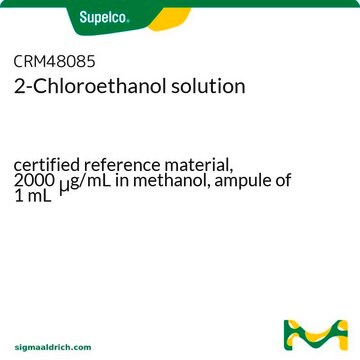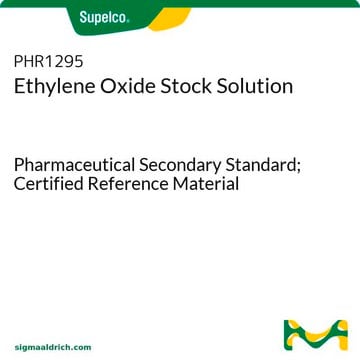If this product has an expiration or retest date, it will be shown on the Certificate of Analysis (COA, CofA). If there is no retest or expiration date listed on the product's COA, we do not have suitable stability data to determine a shelf life. For these products, the only date on the COA will be the release date; a retest, expiration, or use-by-date will not be displayed.
For all products, we recommend handling per defined conditions as printed in our product literature and website product descriptions. We recommend that products should be routinely inspected by customers to ensure they perform as expected.
For products without retest or expiration dates, our standard warranty of 1 year from the date of shipment is applicable.
For more information, please refer to the Product Dating Information document: https://www.sigmaaldrich.com/deepweb/assets/sigmaaldrich/marketing/global/documents/449/386/product-dating-information-mk.pdf
48838
Oxyde d'éthylène solution
certified reference material, 50 mg/mL in methanol
About This Item
Produits recommandés
Qualité
certified reference material
TraceCERT®
Gamme de produits
TraceCERT®
CofA (certificat d'analyse)
current certificate can be downloaded
Caractéristiques
standard type calibration
Conditionnement
ampule of 1 mL
Concentration
50 mg/mL in methanol
Technique(s)
HPLC: suitable
gas chromatography (GC): suitable
Application(s)
agriculture
cleaning products
cosmetics
environmental
food and beverages
personal care
Format
single component solution
Température de stockage
2-8°C
Chaîne SMILES
C1CO1
InChI
1S/C2H4O/c1-2-3-1/h1-2H2
Clé InChI
IAYPIBMASNFSPL-UHFFFAOYSA-N
Vous recherchez des produits similaires ? Visite Guide de comparaison des produits
Description générale
L'oxyde d'éthylène est un liquide inflammable et toxique qui peut être obtenu par l'oxydation de l'éthylène en phase vapeur.[1] Il peut être utilisé dans la synthèse de l'éthylèneglycol[2], d'éthers de glycol, de tensioactifs et d'éthanolamines.[1] C'est une substance chimique qui est importante dans l'industrie et qui peut être employée comme fumigant pour stériliser le matériel médical et dentaire.[2]
Application
Autres remarques
Informations légales
Mention d'avertissement
Danger
Mentions de danger
Classification des risques
Acute Tox. 3 Dermal - Acute Tox. 3 Inhalation - Acute Tox. 3 Oral - Carc. 1B - Eye Dam. 1 - Flam. Liq. 2 - Muta. 1B - Repr. 1B - Skin Corr. 1 - STOT RE 2 - STOT SE 1
Organes cibles
Eyes,Central nervous system, Nervous system
Code de la classe de stockage
3 - Flammable liquids
Classe de danger pour l'eau (WGK)
WGK 3
Point d'éclair (°F)
50.0 °F - closed cup
Point d'éclair (°C)
10 °C - closed cup
Équipement de protection individuelle
Eyeshields, Faceshields, Gloves
Faites votre choix parmi les versions les plus récentes :
Certificats d'analyse (COA)
It looks like we've run into a problem, but you can still download Certificates of Analysis from our Documents section.
Si vous avez besoin d'assistance, veuillez contacter Service Clients
Déjà en possession de ce produit ?
Retrouvez la documentation relative aux produits que vous avez récemment achetés dans la Bibliothèque de documents.
Les clients ont également consulté
-
How can I determine the shelf life / expiration / retest date of this product?
1 answer-
Helpful?
-
-
How is shipping temperature determined? And how is it related to the product storage temperature?
1 answer-
Products may be shipped at a different temperature than the recommended long-term storage temperature. If the product quality is sensitive to short-term exposure to conditions other than the recommended long-term storage, it will be shipped on wet or dry-ice. If the product quality is NOT affected by short-term exposure to conditions other than the recommended long-term storage, it will be shipped at ambient temperature. As shipping routes are configured for minimum transit times, shipping at ambient temperature helps control shipping costs for our customers. For more information, please refer to the Storage and Transport Conditions document: https://www.sigmaaldrich.com/deepweb/assets/sigmaaldrich/marketing/global/documents/316/622/storage-transport-conditions-mk.pdf
Helpful?
-
-
Please supply detailed instructions how to open and extract the chemical from its packing container. The form of the vial is not familiar to me and due to chemical's high toxicity and volatile content we need to handle it with extra care.
1 answer-
The ampule may be opened by holding the top firmly with one hand and the body of the ampule in the other hand. Firmly and steadily bend the cap away from the break point or neck until the vial snaps. Dispose of the cap (containing the broken vial top) into a sharps bin. The item is intended for single-use only. Please review the product SDS for recommended personal protective equipment.
Please see the links below to review products that may be useful in opening ampules:
https://www.sigmaaldrich.com/product/aldrich/z693847
https://www.sigmaaldrich.com/substance/ampulebreakercollar1234598765Helpful?
-
Active Filters
Notre équipe de scientifiques dispose d'une expérience dans tous les secteurs de la recherche, notamment en sciences de la vie, science des matériaux, synthèse chimique, chromatographie, analyse et dans de nombreux autres domaines..
Contacter notre Service technique











